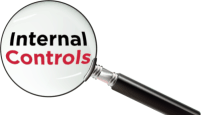Internal Controls
Keep Your Company on Course with Internal Controls
Internal control is defined as “a process for assuring achievement of an organization’s objectives in operational effectiveness and efficiency, reliable financial reporting, and compliance with laws, regulations, and policies.”

These controls allow management to:
- Promote efficiency
- Reduce risk of asset loss
- Ensure the reliability of financial statements and compliance with laws and regulations
If your business is required to obtain an annual financial statement audit for outside financing or other purposes, you may have already implemented internal controls and procedures. However, even if you don’t require an independent audit, you should implement internal controls, and you can start with the advice below:
1. Assign an individual who is independent of the bill pay and receipt/deposit function to receive, open and review your bank statement and any checks (or facsimiles) returned with the statement. That individual should pay special attention to electronic transfers, electronic bill pay and ACH transactions.
2. Select a random sampling of bills paid based on the check facsimiles returned with the bank statement and look for unfamiliar payees, requesting corresponding invoices. Review the signatures on the checks for propriety.
3. Verify that all payroll tax withholdings have been remitted to the appropriate state and federal tax authorities, even if your company uses a payroll service (your company, not the payroll service, is ultimately responsible for remitting these payments). Assign an individual independent of the payroll function to perform this task.
